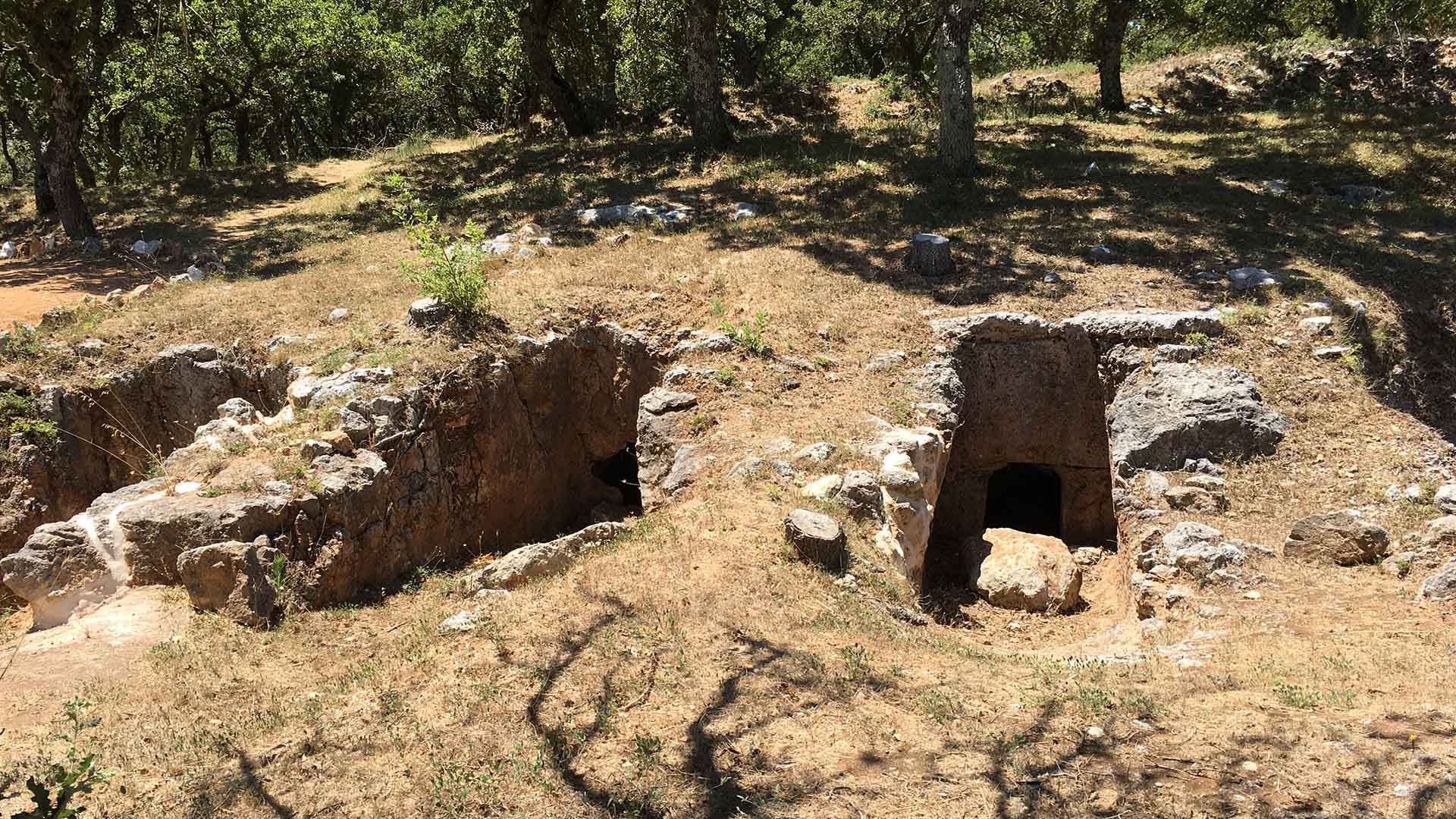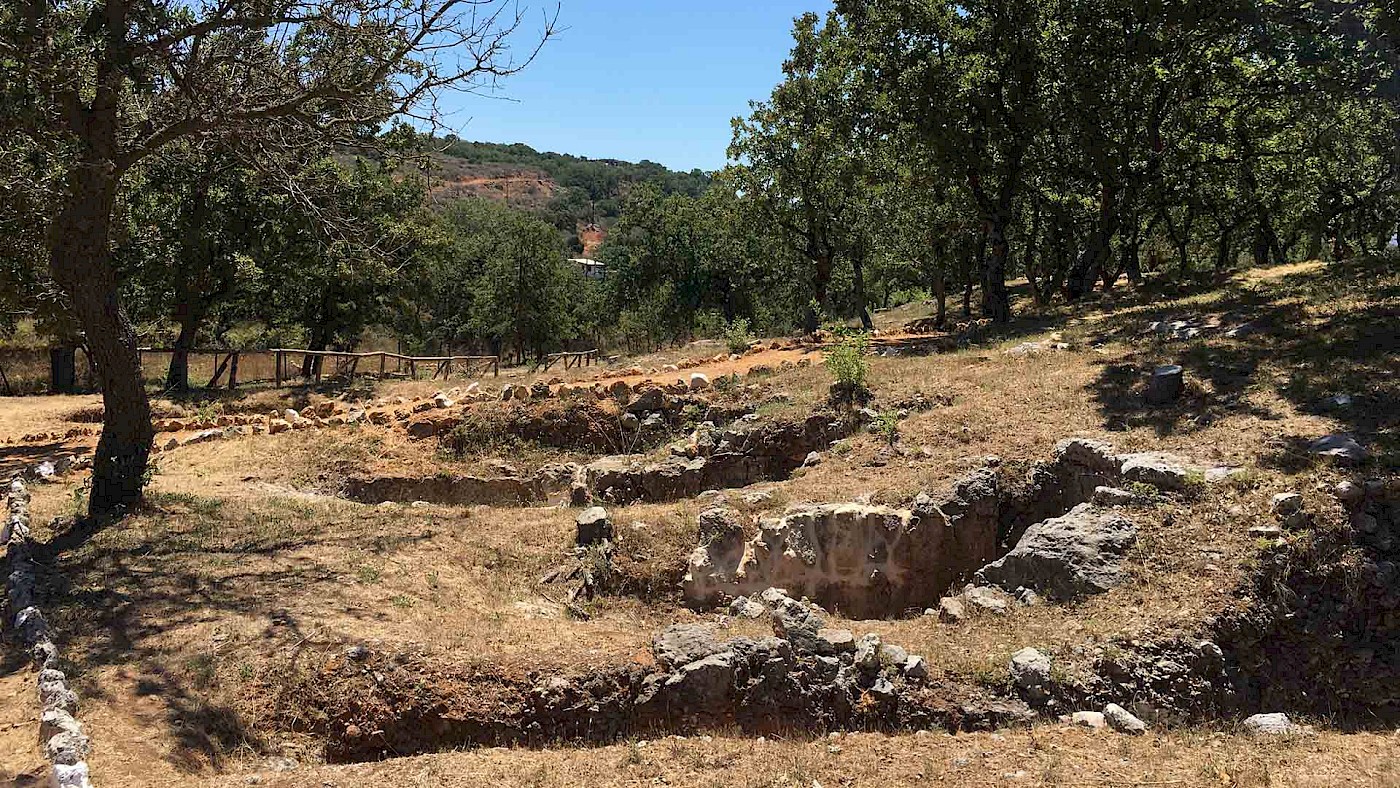Close to the Cretan city of Rethymno, just off the road that connects it with Spilí and Agia Galini, lies the archaeological site of Armenoi. It is an ancient cemetery that, based on the pottery recovered from the tombs, was in use from Late Minoan IIIA1 down to Late Minoan IIIB2, or roughly 1420/1410 to 1200/1190 BC. (See my article here for more details on the chronology of the Aegean Bronze Age.)
Excavations started in 1969 and are still ongoing. When we were there last summer (2020), there was a lone archaeologist working on a single tomb, which had been cordoned off from the rest of the site. The information at the site about the cemetery is sparse, with virtually no signs.
Fortunately, the first volume of the excavations was recently published. The Late Minoan III Necropolis of Armenoi. Vol. 1: Introduction and Background (2018), edited by Yannis Tzedakis, Holley Martlew, and Robert Arnott, is a treasure trove of information.
So far, a total of 232 tombs have been unearthed at Armenoi. Nearly all of them are chamber tombs. A chamber tomb consists of a long, open corridor – a dromos, here often with a short staircase or a ramp – that connects to an inner chamber. The doorway would usually be walled up or, in 85% of the tombs at Armenoi (Tzedakis et al. 2018, p. 7), sealed off with a large stone slab. The chambers contained the bodies and grave goods. However, it should be noted that about a third of the tombs do not have chambers; perhaps these were used as cenotaphs (Tzedakis et al. 2018, p. 9).

Chamber tombs are a feature from mainland Greece; they only appear in Crete during the Late Bronze Age. They are among several signs that Crete at this time was within the mainland sphere of influence. Other signs include the use of Linear B, which was used to record an early form of Greek. Tomb 146 contained a stirrup jar with an inscription in Linear B (see Louis Godart’s contribution in Tzedakis et al. 2018, pp. 249-254). Elsewhere, such as at Agia Triada, we find a form of architecture – the megaron – that is commonly associated with the mainland.
At Armenoi, there is only one tomb (Tomb 200) that is not a chamber tomb, but rather a tholos or “beehive” tomb. The excavators suggest that this is a tholos tomb only because the roof “must have fallen in during construction, after which the Minoans used the ‘tholos’ technique as the stones were suitable. The tholos roof was subsequently restored by us” (Tzedakis et al. 2018, p. 3). In other words, Tomb 200 was intended to be a chamber tomb like all the others, and is a tholos tomb simply by virtue of the original creators not wanting to have their efforts go to waste.
The cemetery is exceptional in more than one way. Aside from the fact that is very extensive, almost none of the tombs here have been destroyed or looted; the few tombs that did get robbed were emptied at an early stage, at the end of the Bronze Age. Most of the grave goods have been taken to nearby museums, and the Archaeological Museum of Rethymno showcases some of the objects. The objects recovered from the tombs include high-quality pottery, bronze tools and weapons, sealstones, as well as a boars’ tusk helmet.

Among the more impressive objects recovered from the tombs are the painted larnakes. A larnax is essentially a large pottery chest. It is rectangular and has four legs that raise it off the ground; a larnax also has a lid. Larnakes were used as coffins: the body was folded up in order to fit. The bottom of a larnax has holes to allow the fluids that are produced as a result of the decomposition process to flow out. Larnakes are often painted; the ones from Aremnoi feature octopusses, bulls, goats, papyrus plants, and so on.
Most larnakes contained a single skeleton; the one exception is a larnax from Tomb 132, “which contained two skeletons, a man and a woman” (Tzedakis et al. 2018, p. 9). One imagines that the two bodies had been close in life (husband and wife?); how did they come to die at more or less the same time?
The necropolis appears to have been carefully planned by its creators, which shouldn’t perhaps be too much of a surprise: Bronze Age tombs in Crete were usually used for many generations. There are two levels to the site, with the earliest tombs built on a lower level and the later tombs at a higher one. The rock is also levelled in places and a Bronze Age road runs through the cemetery.

All of the tombs are oriented in such a way that the entrances face east. In The Late Minoan III Necropolis of Armenoi, Andrew Gize points out that the tombs at Armenoi are not unique as many “ancient monuments show a more generalized solar orientation” (p. 237). Indeed, we can also add the example of later Greek temples, which were often oriented east/west, so that the light of the rising sun would fall on the cult statue inside if the temple’s doors, which faced east, were opened. Gize notes (p. 237):
From the author’s perspective, there are two magical periods daily in the LM III necropolis. During the few hours after dawn, when the air is cool, fresh, and dust free, the new day’s sun shines down the passageways and illuminates the chamber tomb entrances. At the end of the day, as the sun sets behind the ridge, the shadows lengthen, creep over the ground, and cover the tombs in preparation for the night. In the author’s view, this reflects the birth and death through the passage of the sun, repeated daily for eternity.
The cemetery is located in an area rich in archaeological finds. It probably belonged to a Minoan settlement located 2 kilometres away located underneath the Venetian village of Kastellos. Excavations there are currently ongoing. The rich finds from the cemetery suggest that the town itself was affluent, and the authors of the first volume on Armenoi note that the town “would have occupied a strategic position on the north-south road, and it therefore would have been able to control the trade along this route of animals, wool, wine, oil, and additional agricultural products, as well as copper and semiprecious stones” (p. 3).
All in all, the cemetery at Armenoi is a key archaeological site for Late Bronze Age Crete. It is a pity that the site itself has little information to offer visitors, so it pays to read up on the site beforehand and to see some of the objects – most of which we are sadly not allowed to photograph! – in the museums of Rethymno and Chania.
